Web Programming Step by Step, 2nd Edition
Chapter 8: JavaScript
Except where otherwise noted, the contents of this document are Copyright 2012 Marty Stepp, Jessica Miller, and Victoria Kirst. All rights reserved. Any redistribution, reproduction, transmission, or storage of part or all of the contents in any form is prohibited without the author's expressed written permission.
8.1: Key JavaScript Concepts
- 8.1: Key JavaScript Concepts
- 8.2, 8.3, 8.4: JavaScript Syntax
- Object-oriented JavaScript Features
Client-side scripting
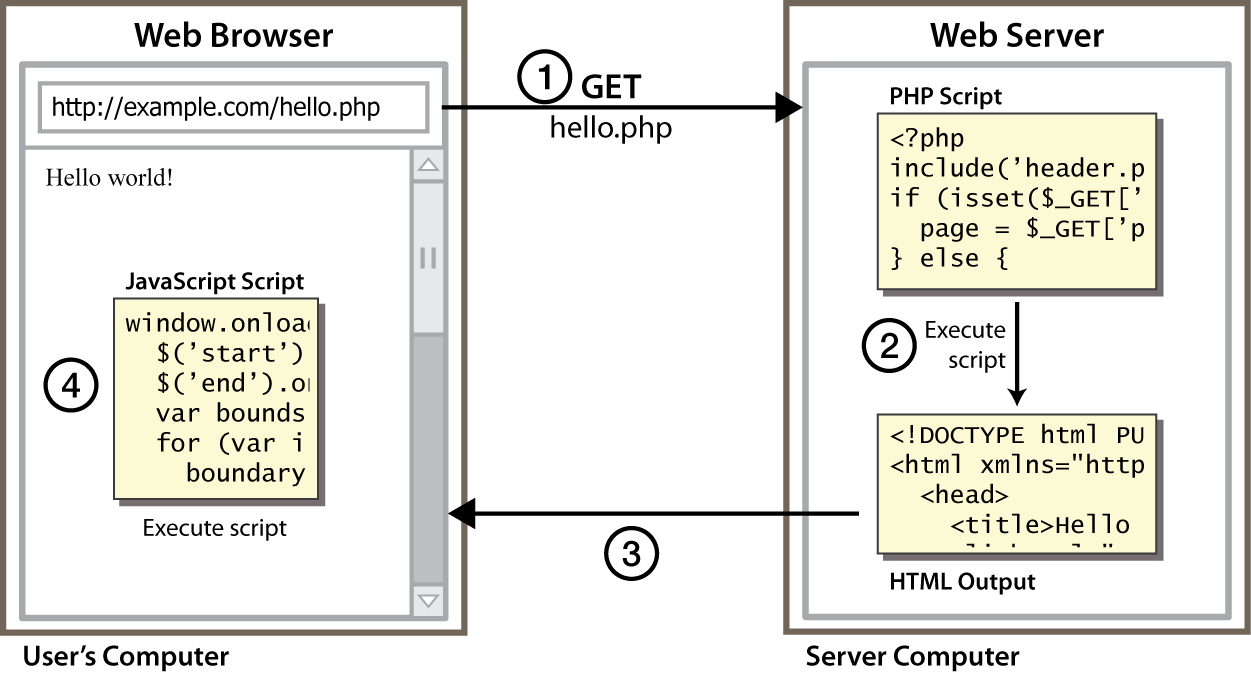
- client-side script: code runs in browser after page is sent back from server
- often this code manipulates the page or responds to user actions
Why use client-side programming?
PHP already allows us to create dynamic web pages. Why also use client-side scripting?
-
client-side scripting (JavaScript) benefits:
- usability: can modify a page without having to post back to the server (faster UI)
- efficiency: can make small, quick changes to page without waiting for server
- event-driven: can respond to user actions like clicks and key presses
-
server-side programming (PHP) benefits:
- security: has access to server's private data; client can't see source code
- compatibility: not subject to browser compatibility issues
- power: can write files, open connections to servers, connect to databases, ...
What is JavaScript?
- a lightweight programming language ("scripting language")
- used to make web pages interactive
- insert dynamic text into HTML (ex: user name)
- react to events (ex: page load user click)
- get information about a user's computer (ex: browser type)
- perform calculations on user's computer (ex: form validation)
- a web standard (but not supported identically by all browsers)
- NOT related to Java other than by name and some syntactic similarities
JavaScript vs. Java
 +
+
 = JavaScript
= JavaScript
- interpreted, not compiled
- more relaxed syntax and rules
- fewer and "looser" data types
- variables don't need to be declared
- errors often silent (few exceptions)
- key construct is the function rather than the class
- "first-class" functions are used in many situations
- contained within a web page and integrates with its HTML/CSS content
JavaScript vs. PHP
JS <3


- similarities:
- both are interpreted, not compiled
- both are relaxed about syntax, rules, and types
- both are case-sensitive
- both have built-in regular expressions for powerful text processing
- differences:
- JS is more object-oriented:
noun.verb(), less procedural:verb(noun) - JS focuses on UIs and interacting with a document; PHP on HTML output and files/forms
- JS code runs on the client's browser; PHP code runs on the web server
- JS is more object-oriented:
Linking to a JavaScript file:
script
<script src="filename" type="text/javascript"></script>
<script src="example.js" type="text/javascript"></script>
scripttag should be placed in HTML page'shead- script code is stored in a separate
.jsfile - JS code can be placed directly in the HTML file's
bodyorhead(like CSS)- but this is bad style (should separate content, presentation, and behavior)
A JavaScript statement:
alert
alert("message");
alert("IE6 detected. Suck-mode enabled.");
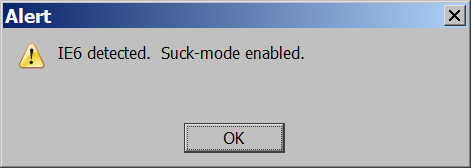
- a JS command that pops up a dialog box with a message
Variables and types
var name = expression;
var age = 32; var weight = 127.4; var clientName = "Connie Client";
- variables are declared with the
varkeyword (case sensitive) - types are not specified, but JS does have types ("loosely typed")
Number,Boolean,String,Array,Object,Function,Null,Undefined- can find out a variable's type by calling
typeof
String type
var s = "Connie Client";
var fName = s.substring(0, s.indexOf(" ")); // "Connie"
var len = s.length; // 13
var s2 = 'Melvin Merchant'; // can use "" or ' '
- methods:
charAt,charCodeAt,fromCharCode,indexOf,lastIndexOf,replace,split,substring,toLowerCase,toUpperCasecharAtreturns a one-letterString(there is nochartype)
lengthproperty (not a method as in Java)-
concatenation with
+:1+ 1 is2, but"1"+ 1 is"11"
Event-driven programming
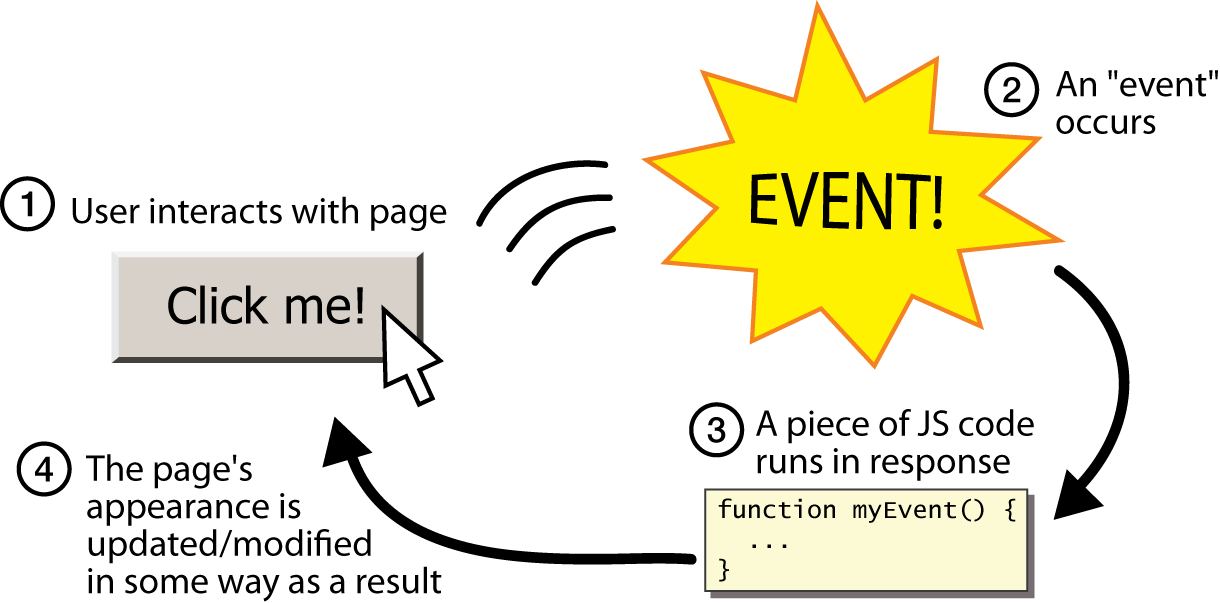
- JS programs have no
main; they respond to user actions called events - event-driven programming: writing programs driven by user events
Buttons:
<button>
the canonical clickable UI control (inline)
<button>Click me!</button>
- button's text appears inside tag; can also contain images
- To make a responsive button or other UI control:
- choose the control (e.g. button) and event (e.g. mouse click) of interest
- write a JavaScript function to run when the event occurs
- attach the function to the event on the control
JavaScript functions
function name() {
statement ;
statement ;
...
statement ;
}
function myFunction() {
alert("Hello!");
alert("How are you?");
}
- the above could be the contents of
example.jslinked to our HTML page - statements placed into functions can be evaluated in response to user events
Event handlers
<element attributes onclick="function();">...
<button onclick="myFunction();">Click me!</button>
- JavaScript functions can be set as event handlers
- when you interact with the element, the function will execute
onclickis just one of many event HTML attributes we'll use
-
but popping up an
alertwindow is disruptive and annoying- A better user experience would be to have the message appear on the page...
Document Object Model (DOM)
a set of JavaScript objects that represent each element on the page
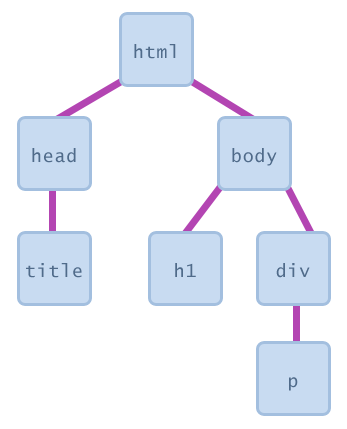
- most JS code manipulates elements on an HTML page
- we can examine elements' state
- e.g. see whether a box is checked
- we can change state
- e.g. insert some new text into a
div
- e.g. insert some new text into a
- we can change styles
- e.g. make a paragraph red
DOM element objects
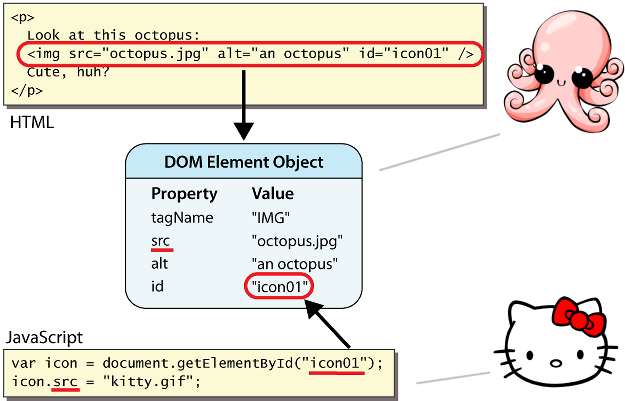
- every element on the page has a corresponding DOM object
-
access/modify the attributes of the DOM object with
objectName.attributeName
Accessing elements: document.getElementById
var name = document.getElementById("id");
<button onclick="changeText();">Click me!</button> <input id="output" type="text" value="replace me" />
function changeText() {
var textbox = document.getElementById("output");
textbox.value = "Hello, world!";
}
-
document.getElementByIdreturns the DOM object for an element with a givenid -
can change the text in most form controls by setting the
valueproperty
More advanced example
<button onclick="swapText();">Click me!</button> <span id="output2">Hello</span> <input id="textbox2" type="text" value="Goodbye" />
function swapText() {
var span = document.getElementById("output2");
var textBox = document.getElementById("textbox2");
var temp = span.innerHTML;
span.innerHTML = textBox.value;
textBox.value = temp;
}
-
can change the text inside most elements by setting the
innerHTMLproperty
8.2 - 8.4: JavaScript Syntax
- 8.1: Key JavaScript Concepts
- 8.2, 8.3, 8.4: JavaScript Syntax
- Object-oriented JavaScript Features
Number type
var enrollment = 99; var medianGrade = 2.8; var credits = 5 + 4 + (2 * 3);
- integers and real numbers are the same type (no
intvs.double) -
same operators:
+ - * / % ++ -- = += -= *= /= %= - similar precedence to Java
- many operators auto-convert types:
"2" * 3is6
Comments (same as Java)
// single-line comment
/* multi-line comment */
- identical to Java's comment syntax
- recall: 4 comment syntaxes
- HTML:
<!-- comment --> - CSS/JS/PHP:
/* comment */ - Java/JS/PHP:
// comment - PHP:
# comment
- HTML:
More about String
-
escape sequences behave as in Java:
\' \" \& \n \t \\ - converting between numbers and
Strings:var count = 10; var s1 = "" + count; // "10" var s2 = count + " bananas, ah ah ah!"; // "10 bananas, ah ah ah!" var n1 = parseInt("42 is the answer"); // 42 var n2 = parseFloat("booyah"); // NaN
- accessing the letters of a
String:var firstLetter = s[0]; // fails in IE var firstLetter = s.charAt(0); // does work in IE var lastLetter = s.charAt(s.length - 1);
for loop
(same as Java)
for (initialization; condition; update) {
statements;
}
var sum = 0;
for (var i = 0; i < 100; i++) {
sum = sum + i;
}
var s1 = "hello";
var s2 = "";
for (var i = 0; i < s.length; i++) {
s2 += s1.charAt(i) + s1.charAt(i);
}
// s2 stores "hheelllloo"
Math object
var rand1to10 = Math.floor(Math.random() * 10 + 1); var three = Math.floor(Math.PI);
Special values: null and undefined
var ned = null;
var benson = 9;
var caroline;
// at this point in the code,
// ned is null
// benson's 9
// caroline is undefined
undefined: has not been declared, does not existnull: exists, but was specifically assigned an empty ornullvalue- Why does JavaScript have both of these?
Logical operators
-
> < >= <= && || ! == != === !== -
most logical operators automatically convert types:
-
5 < "7"istrue -
42 == 42.0istrue "5.0" == 5istrue
-
-
===and!==are strict equality tests; checks both type and value-
"5.0" === 5isfalse
-
if/else statement
(same as Java)
if (condition) {
statements;
} else if (condition) {
statements;
} else {
statements;
}
- identical structure to Java's
if/elsestatement - JavaScript allows almost anything as a condition
Boolean type
var iLike190M = true; var ieIsGood = "IE6" > 0; // false if ("web dev is great") { /* true */ } if (0) { /* false */ }
-
 any value can be used as a
any value can be used as a Boolean-
"falsey" values:
0,0.0,NaN,"",null, andundefined - "truthy" values: anything else
-
"falsey" values:
- converting a value into a
Booleanexplicitly:var boolValue = Boolean(otherValue);var boolValue = !!(otherValue);
while loops
(same as Java)
while (condition) {
statements;
}
do {
statements;
} while (condition);
breakandcontinuekeywords also behave as in Java
Popup boxes
alert("message"); // message
confirm("message"); // returns true or false
prompt("message"); // returns user input string

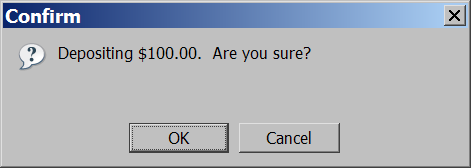
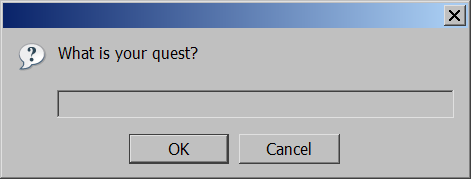
Arrays
var name = []; // empty array var name = [value, value, ..., value]; // pre-filled name[index] = value; // store element
var ducks = ["Huey", "Dewey", "Louie"]; var stooges = []; // stooges.length is 0 stooges[0] = "Larry"; // stooges.length is 1 stooges[1] = "Moe"; // stooges.length is 2 stooges[4] = "Curly"; // stooges.length is 5 stooges[4] = "Shemp"; // stooges.length is 5
- two ways to initialize an array
lengthproperty (grows as needed when elements are added)
Array methods
var a = ["Stef", "Jason"]; // Stef, Jason a.push("Brian"); // Stef, Jason, Brian a.unshift("Kelly"); // Kelly, Stef, Jason, Brian a.pop(); // Kelly, Stef, Jason a.shift(); // Stef, Jason a.sort(); // Jason, Stef
Splitting strings:
split and join
var s = "the quick brown fox";
var a = s.split(" "); // ["the", "quick", "brown", "fox"]
a.reverse(); // ["fox", "brown", "quick", "the"]
s = a.join("!"); // "fox!brown!quick!the"
-
splitbreaks apart a string into an array using a delimiter- can also be used with regular expressions (seen later)
joinmerges an array into a single string, placing a delimiter between them
DOM element objects

- every element on the page has a corresponding DOM object
-
access/modify the attributes of the DOM object with
objectName.attributeName
DOM object properties
<div id="main" class="foo bar"> <p>Hello, <em>very</em> happy to see you!</p> <img id="icon" src="images/borat.jpg" alt="Borat" /> </div>
| Property | Description | Example |
|---|---|---|
tagName
|
element's HTML tag |
$("main").tagName is "DIV"
|
className
|
CSS classes of element |
$("main").className is "foo bar"
|
innerHTML
|
content inside element |
$("main").innerHTML is "\n <p>Hello, <em>ve...
|
src
|
URL target of an image |
$("icon").src is "images/borat.jpg"
|
DOM properties for form controls
<input id="sid" type="text" size="7" maxlength="7" /> <input id="frosh" type="checkbox" checked="checked" /> Freshman?
| Property | Description | Example |
|---|---|---|
value
|
the text in an input control |
$("sid").value could be "1234567"
|
checked
|
whether a box is checked |
$("frosh").checked is true
|
disabled
|
whether a control is disabled (boolean) |
$("frosh").disabled is false
|
readOnly
|
whether a text box is read-only |
$("sid").readOnly is false
|
Modifying text inside an element
var paragraph = document.getElementById("welcome");
paragraph.innerHTML = "Welcome to our site!"; // change text on page
DOM element objects have the following properties:
innerHTML: text and/or HTML tags inside a nodetextContent: text (no HTML tags) inside a node-
simpler than
innerHTML, but not supported in IE6
-
simpler than
value: the value inside a form control
Abuse of innerHTML
// bad style!
var paragraph = document.getElementById("welcome");
paragraph.innerHTML = "<p>text and <a href="page.html">link</a>";
innerHTMLcan inject arbitrary HTML content into the page- however, this is prone to bugs and errors and is considered poor style
- we forbid using
innerHTMLto inject HTML tags; inject plain text only- (later, we'll see a better way to inject content with HTML tags in it)
Adjusting styles with the DOM
<button id="clickme">Color Me</button>
window.onload = function() {
document.getElementById("clickme").onclick = changeColor;
};
function changeColor() {
var clickMe = document.getElementById("clickme");
clickMe.style.color = "red";
}
| Property | Description |
|---|---|
style
|
lets you set any CSS style property for an element |
- contains same properties as in CSS, but with
camelCasedNames- examples:
backgroundColor,borderLeftWidth,fontFamily
- examples:
Common DOM styling errors
- many students forget to write
.stylewhen setting stylesvar clickMe = document.getElementById("clickme");clickMe.color = "red";clickMe.style.color = "red"; - style properties are capitalized
likeThis, notlike-thisclickMe.style.font-size = "14pt";clickMe.style.fontSize = "14pt"; - style properties must be set as strings, often with units at the end
clickMe.style.width = 200;clickMe.style.width = "200px"; clickMe.style.padding = "0.5em";- write exactly the value you would have written in the CSS, but in quotes
JavaScript in HTML body (example)
<script type="text/javascript"> JavaScript code </script>
- JS code can be embedded within your HTML page's
headorbody - runs as the page is loading
- this is considered bad style and shouldn't be done in this course
- mixes HTML content and JS scripts (bad)
- can cause your page not to validate
Injecting Dynamic Text: document.write
document.write("message");
- prints specified text into the HTML page
- this is very bad style; this is how newbs program JavaScript:
- putting JS code in the HTML file's
body - having that code use
document.write - (this is awful style and a poor substitute for server-side PHP programming, which we'll learn later)
- putting JS code in the HTML file's
The typeof function
typeof(value)
- given these declarations:
function foo() { alert("Hello"); }var a = ["Huey", "Dewey", "Louie"];
- The following statements are
true:typeof(3.14) === "number"typeof("hello") === "string"typeof(true) === "boolean"typeof(foo) === "function"typeof(a) === "object"typeof(null) === "object"typeof(undefined) === "undefined"
The arguments array
function example() {
for (var i = 0; i < arguments.length; i++) {
alert(arguments[i]);
}
}
example("how", "are", "you"); // alerts 3 times
- every function contains an array named
argumentsrepresenting the parameters passed - can loop over them, print/alert them, etc.
- allows you to write functions that accept varying numbers of parameters
The "for each" loop
for (var name in arrayOrObject) {
do something with arrayOrObject[name];
}
- loops over every index of the array, or every property name of the object
- using this is actually discouraged, for reasons we'll see later
Arrays as maps
var map = []; map[42] = "the answer"; map[3.14] = "pi"; map["champ"] = "suns";
- the indexes of a JS array need not be integers!
- this allows you to store mappings between an index of any type ("keys") and value
- similar to Java's
Mapcollection or a hash table data structure
Date object
var today = new Date(); // today var midterm = new Date(2007, 4, 4); // May 4, 2007
- methods
- quirks
getYearreturns a 2-digit year; usegetFullYearinsteadgetDayreturns day of week from 0 (Sun) through 6 (Sat)getDatereturns day of month from 1 to (# of days in month)Datestores month from 0-11 (not from 1-12)
The eval (evil?) function
eval("JavaScript code");
eval("var x = 7; x++; alert(x / 2);"); // alerts 4

evaltreats a String as JavaScript code and runs that code- this is occasionally useful, but usually a very bad idea
- if the string's contents come from user input, the user can cause arbitrary code execution
- can lead to security problems and bugs
Object-oriented JavaScript Features
- 8.1: Key JavaScript Concepts
- 8.2, 8.3, 8.4: JavaScript Syntax
- Object-oriented JavaScript Features
Why use classes and objects?
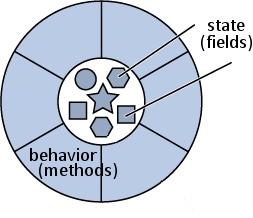
- small programs are easily written without objects
- JavaScript treats functions as first-class citizens
- larger programs become cluttered with disorganized functions
- objects group related data and behavior
- helps manage size and complexity, promotes code reuse
-
You have already used many types of JavaScript objects
- Strings, arrays, HTML / XML DOM nodes
-
Prototype
Ajax.Request, ScriptaculousEffect/Sortable/Draggable
Creating a new anonymous object
var name = {
fieldName: value,
...
fieldName: value
};
var pt = {
x: 4,
y: 3
};
alert(pt.x + ", " + pt.y);
- in JavaScript, you can create a new object without creating a class
- the above is like a
Pointobject; it has fields namedxandy - the object does not belong to any class; it is the only one of its kind
-
typeof(pt) === "object"
-
Objects that have behavior (functions/methods)
var name = {
...
methodName: function(parameters) {
statements;
}
};
var pt = {
x: 4, y: 3,
distanceFromOrigin: function() {
return Math.sqrt(this.x * this.x + this.y * this.y);
}
};
alert(pt.distanceFromOrigin()); // 5
- like in Java, objects' methods run "inside" that object
- inside an object's method, the object refers to itself as
this - unlike in Java, the
thiskeyword is mandatory in JS
- inside an object's method, the object refers to itself as
A poor attempt at a "constructor"
What if we want to create an entire new class, not just one object?
- JavaScript, unlike Java, does NOT have classes
- we could emulate the functionality of a constructor with a function:
// Creates and returns a new Point object. (This is bad code.) function constructPoint(xValue, yValue) { var pt = { x: xValue, y: yValue, distanceFromOrigin: function() { return Math.sqrt(this.x * this.x + this.y * this.y; } }; return pt; }var p = constructPoint(4, -3);
-
the above code is ugly and doesn't match the
newsyntax we're used to
Constructor functions
// Constructs and returns a new Point object.
function Point(xValue, yValue) {
this.x = xValue;
this.y = yValue;
this.distanceFromOrigin = function() {
return Math.sqrt(this.x * this.x + this.y * this.y);
};
}
var p = new Point(4, -3);
- a constructor is just a normal function
-
when any function called with
new, JavaScript does the following:-
creates a new empty anonymous object and uses it as
thiswithin the function - implicitly returns the new object at the end of the function
-
creates a new empty anonymous object and uses it as
-
what happens if our "constructor" is called as a normal function, without
new?var p = Point(4, -3);
Problems with our constructor
// Constructs and returns a new Point object.
function Point(xValue, yValue) {
this.x = xValue;
this.y = yValue;
this.distanceFromOrigin = function() {
return Math.sqrt(this.x * this.x + this.y * this.y);
};
}
- ugly syntax; every method must be declared inside the constructor
-
(subtle) replicates the methods in every object (wasteful)
-
every
Pointobject has its own entire copy of thedistanceFromOrigincode
-
every
A paradigm shift: prototypes
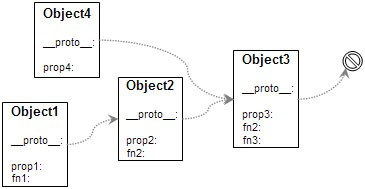
-
prototype: an ancestor of a JavaScript object
- like a "super-object" instead of a superclass
- a parent at the object level rather than at the class level
- not to be confused with Prototype framework
-
every object contains a reference to its prototype
-
the default is
Object.prototype -
strings use
String.prototype, etc. - a prototype can have a prototype, and so on
-
the default is
-
an object "inherits" all methods/data from its prototype(s)
- it doesn't have to make a copy of them, which saves memory
- prototypes allow JavaScript to mimic classes and inheritance
An object's prototype chain

-
when you try to look up a property or method in an object, JavaScript:
- Sees if the object itself contains that property/method.
- If not, recursively checks the object's prototype to see if it has the property/method.
-
Continues up the "prototype chain" until it finds the property/method or gives up with
undefined.
Constructors and prototypes
// also causes Point.prototype to become defined
function Point(xValue, yValue) {
...
}
-
every constructor also has an associated prototype object
-
example: when we define our
Pointconstructor, that creates aPoint.prototype - initially this object has nothing in it
-
example: when we define our
-
every object you construct will use the constructor's prototype object as its prototype
-
example: every constructed
Pointobject will usePoint.prototype
-
example: every constructed
-
(revised) when any function called with
new, JavaScript does the following:- creates a new empty anonymous object
- attaches the function's prototype object to the new object as its prototype
-
runs the constructor's code, using the new object as
this - implicitly returns the new object at the end of the function
Modifying a prototype
// adding a method to the prototype
className.prototype.methodName = function(parameters) {
statements;
}
Point.prototype.distanceFromOrigin = function() {
return Math.sqrt(this.x * this.x + this.y * this.y);
};
-
adding a method/field to a prototype will give it to all objects using that prototype
- better than manually adding each method to each object (copying the method N times)
-
we generally put only methods and constant data (not fields!) in a prototype object
-
what would happen if we put the
xandyfields inPoint.prototype?
-
what would happen if we put the
-
Exercise: Add
distanceandtoStringmethods.
Point prototype methods
// Computes the distance between this point and the given point p. Point.prototype.distance = function(p) { var dx = this.x - p.x; var dy = this.y - p.y; return Math.sqrt(dx * dx + dy * dy); }; // Returns a text representation of this object, such as "(3, -4)". Point.prototype.toString = function() { return "(" + this.x + ", " + this.y + ")"; };
- our
Pointcode could be saved into a filePoint.js - the
toStringmethod works similarly as in Java
Modifying built-in prototypes
// add a 'contains' method to all String objects String.prototype.contains = function(text) { return this.indexOf(text) >= 0; }; // add a 'lightUp' method to all HTML DOM element objects HTMLElement.prototype.lightUp = function() { this.style.backgroundColor = "yellow"; this.style.fontWeight = "bold"; };
-
ANY prototype can be modified, including those of existing types
- Prototype and other libraries do this
- not quite the same as adding something to a single object
-
Exercise: Add a
reversemethod to strings. -
Exercise: Add a
shufflemethod to arrays.
Practice problem: Favorite Movies
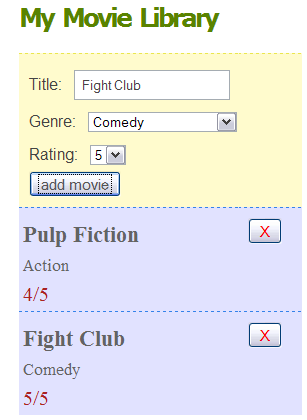
-
Add JavaScript to
moviegallery.htmlto list your favorite movies. -
Create a new type called
Movie:Movie(title, genre, rating)- constructor.createHTML()- Creates and returns an HTML DOM object representing adivholding the HTML for this movie.<div class="movie"> <button class="delete">X</button> <p class="title">Indiana Jones 4</p> <p class="genre">Action/Adventure</p> <p class="rating">3/5</p> </div>
deleteMe()- Removes the movie from the page.
Pseudo-inheritance with prototypes
function SuperClassName(parameters) { // "superclass" constructor
...
};
function SubClassName(parameters) { // "subclass" constructor
...
};
SubClassName.prototype = new SuperClassName(parameters); // connect them
- to make a "subclass", tell its constructor to use a "superclass" object as its prototype
-
why not just write it this way?
SubClassName.prototype = SuperClassName.prototype; // connect them
Pseudo-inheritance example
// Constructor for Point3D "class" function Point3D(x, y, z) { this.x = x; this.y = y; this.z = z; }; Point3D.prototype = new Point(0, 0); // set as "subclass" of Point // override distanceFromOrigin method Point3D.prototype.distanceFromOrigin = function() { return Math.sqrt(this.x * this.x + this.y * this.y + this.z * this.z); };
-
mostly works fine, but there no equivalent of the
superkeyword - no built-in way to call an overridden method
- no easy way to call the superclass's constructor

